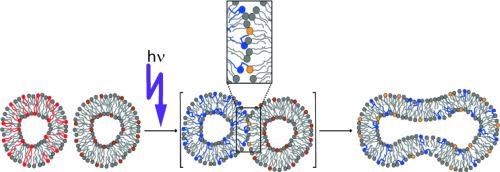Biochimica et Biophysica Acta (BBA) - Biomembranes ( IF 3.4 ) Pub Date : 2020-08-08 , DOI: 10.1016/j.bbamem.2020.183438 Holger A Scheidt 1 , Katja Kolocaj 2 , David B Konrad 3 , James A Frank 4 , Dirk Trauner 5 , Dieter Langosch 2 , Daniel Huster 1

|
The fusion of lipid membranes is central to many biological processes and requires substantial structural reorganization of lipids brought about by the action of fusogenic proteins. Previous molecular dynamics simulations have suggested that splayed lipids, whose tails transiently contact the headgroup region of the bilayer, initiate lipid mixing. Here, we explore the lipid splay hypothesis experimentally. We show that the light-induced trans/cis conversion of the azobenzene-based tail of a model lipid molecule enhances the probability by which its own acyl chains, or the acyl chains of the host lipid, transiently contact the lipid headgroup in a liposomal bilayer. At the same time, the trans/cis conversion triggers lipid mixing of sonicated or extruded liposomes, without requiring fusogenic proteins. This establishes a causal relationship between lipid splay and membrane fusion.
中文翻译:

光诱导的脂质混合暗示脂质膨胀在膜融合中的因果作用。
脂质膜的融合是许多生物学过程的核心,需要融合蛋白的作用引起的脂质的实质性结构重组。先前的分子动力学模拟表明,张开的脂质(其尾部短暂接触双层的头基区域)会引发脂质混合。在这里,我们通过实验探索脂质膨胀假说。我们表明光诱导的模型脂质分子的基于偶氮苯的尾巴的反式/顺式转换提高了其自身的酰基链或宿主脂质的酰基链通过瞬时接触脂质体双层中的脂质头基的可能性。同时,反/顺转化触发超声处理或挤出的脂质体的脂质混合,而无需融合蛋白。这在脂质膨胀和膜融合之间建立了因果关系。


























 京公网安备 11010802027423号
京公网安备 11010802027423号